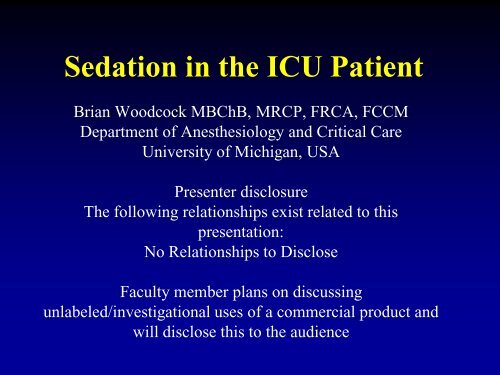Sedation in ICU Patients
Sedation in ICU Patients
Sedation in ICU Patients
You also want an ePaper? Increase the reach of your titles
YUMPU automatically turns print PDFs into web optimized ePapers that Google loves.
<strong>Sedation</strong> <strong>in</strong> <strong>ICU</strong> <strong>Patients</strong>• Old agents for sedation– Benzodiazep<strong>in</strong>es– Opioids– Propofol• Problems with delerium• New agents– Dexmedetomid<strong>in</strong>e– Ketam<strong>in</strong>e– Fospropofol
Traditional <strong>ICU</strong> <strong>Sedation</strong>• Opioids• Benzodiazep<strong>in</strong>es– Midazolam– Lorazepam– Diazepam• Propofol
GABA Receptor
Lorazepam Dose and Probability ofDeliriumPandharipande. Anesthesiology 2006
Effect of Midazolam on Delirium
Avoid<strong>in</strong>g GABA Agonist relatedDelirium• Don’t sedate• Target appropriate sedation levels• Daily <strong>in</strong>terruption of sedation– Drug holidays
Effect of Daily Interruption of<strong>Sedation</strong>P < 0.0001Kress, NEJM, 2000
Effect of Daily Interruption of<strong>Sedation</strong>P = 0.02Kress, NEJM, 2000
Delirium: A never event?• Delirium proposed by CMS as a “Never Event”2008• “Never Events” are errors <strong>in</strong> medical care that areclearly identifiable, preventable, and serious <strong>in</strong>consequences and <strong>in</strong>dicate a problem <strong>in</strong> the safetyof a healthcare facility• Medicare List of Unreimbursed PreventableConditions
Delirium• Incidence <strong>in</strong> Surgical and Thoracic Intensive CareUnits– 11% to 80%• Each additional day of delirium– Increases the risk of prolonged hospitalization by 20%– Increases the likelihood of a poor functional status at 3and 6 months• Delirium is associated with $15k to $25k higherhospital costs• Delirious patients have a 5X <strong>in</strong>crease <strong>in</strong> selfextubation
Modifiable Risk Factors• Lack of social <strong>in</strong>teraction• Frequent nurs<strong>in</strong>g care• Medications• Pa<strong>in</strong>• Sleep disturbance
Treatment StrategiesMaldonado. Crit Care Cl<strong>in</strong>. 2008
Reduction <strong>in</strong> Mortality with HaloperidolMilbrandt Crit Care Med 2005
Haloperidol Side Effects• Prolongation of QT <strong>in</strong>terval– Torsade de Po<strong>in</strong>tes ventricular tachycardia• Extrapyramidal side effects– Very rare with IV use of haloperidol• Neurolept malignant syndrome– Aga<strong>in</strong> very rare with IV use
Pharmacologic Profiles ofAntipsychoticsCasey. J Cl<strong>in</strong> Psych. 1997
Effect of Quetiap<strong>in</strong>e on Incidence andDuration of Delirium• 36 adult <strong>in</strong>tensive care unit patients withdelirium• Quetiap<strong>in</strong>e 50mg BID• Increased by 50mg every 12 hrs ifhaloperidol required• Reduced <strong>in</strong>cidence and duration ofdelirium.Devl<strong>in</strong>, Crit Care Med 2010
Effect of Quetiap<strong>in</strong>e on Incidence andDuration of DeliriumDevl<strong>in</strong>, Crit Care Med 2010
Risperidone and Delirium• Double-bl<strong>in</strong>d randomized trial• S<strong>in</strong>gle dose (1 mg) of risperidoneadm<strong>in</strong>istered after cardiac surgery– subl<strong>in</strong>gual• Reduced the <strong>in</strong>cidence of postoperativedelirium– 11.1% vs. 31.7%, P=.009– RR=0.35, 95% CI=0.16-0.77Prakanrattana, et al. Anaesth Intensive Care. 2007
Dexmedetomid<strong>in</strong>e• α2-receptor agonist• Properties similar to natural sleep– sedated but arousable• Analgesic properties• Side effects– Hypotension– Bradycardia– S<strong>in</strong>us arrest– No respiratory depression• Short distribution half-life (t½) - 6 m<strong>in</strong>utes• Term<strong>in</strong>al elim<strong>in</strong>ation half-life (t½) - 2 hours
MENDS• Maximiz<strong>in</strong>g Efficacy of Targeted <strong>Sedation</strong> andReduc<strong>in</strong>g Neurological Dysfunction Study• 106 adult mechanically ventilated medical andsurgical <strong>ICU</strong> patients• Titrated to RASS• Randomized to dexmedetomid<strong>in</strong>e or lorazepam• t1/2 of unconjugated lorazepam is 12 hours• Major metabolite, lorazepam glucuronide, t1/2about 18 hoursPandharipande, JAMA, 2007
MENDSPandharipande, JAMA, 2007
SEDCOM• Safety and Efficacy of Dexmedetomid<strong>in</strong>eCompared With Midazolam Study Group• Prospective, double-bl<strong>in</strong>d, randomized trial• 68 centers <strong>in</strong> 5 countries• 375 medical/surgical <strong>ICU</strong> patients• Expected mechanical ventilation for morethan 24 hoursRiker, JAMA, 2009
SEDCOM: Prevalence of DeliriumRiker, JAMA, 2009
SEDCOM: Time to ExtubationRiker, JAMA, 2009
SEDCOMRiker, JAMA, 2009
Dexmedetomid<strong>in</strong>e for <strong>Sedation</strong> afterCPB for Valve SurgeriesMaldonado, Psychosomatics, 2009
Fast Track Cardiac Surgery• Recovery room extubation• CABG +/- valve• Dexmedetomid<strong>in</strong>e vs propofol sedation• Retrospective• <strong>Patients</strong> were matched accord<strong>in</strong>g to surgerytype and left ventricular ejection fractionBarletta, Pharmacotherapy, 2009
Fast Track Cardiac SurgeryBarletta, Pharmacotherapy, 2009
Ketam<strong>in</strong>e for Intubation on the <strong>ICU</strong>?• Etomidate is the least cardiac depressant<strong>in</strong>duction agent– Known to cause adrenal suppression on<strong>in</strong>fusion• Ketam<strong>in</strong>e is sympathomimetic– Raises BP and heart rate– Can cause halluc<strong>in</strong>ations
Etomidate vs Ketam<strong>in</strong>e forIntubation• Emergency <strong>in</strong>tubation– 12EDs and 65 <strong>ICU</strong>s <strong>in</strong> France• 469 patients• No difference <strong>in</strong>:– SOFA scores– Probability of be<strong>in</strong>g on ventilation– Vasopressors requirementJabre, Lancet, 2009
Etomidate vs Ketam<strong>in</strong>e forIntubationKetam<strong>in</strong>eEtomidateP=0.36Jabre, Lancet, 2009
Adrenal Effects of Etomidate vsKetam<strong>in</strong>e16(11-15) 25(17-34)18(12-29) 33(25-41)19(14-30) 38(28-48)9 mcg/dL,10 mcg/dL,9 mcg/dLJabre, Lancet, 2009
Propofol• Risks– Not reliably amnestic, especially at low doses– No analgesia!– Hypotension– Respiratory depression– Propofol Infusion Syndrome• Cardiac failure, rhabdomyolysis, severe metabolic acidosis,and renal failure• Caution should be exercised at doses > 80 mcg/kg/m<strong>in</strong> formore than 48 hours• Problematic when used simultaneously with catecholam<strong>in</strong>esand/or steroids
Propofol• Formulated <strong>in</strong> 10% Intralipid– Egg phosphatid and soy lecith<strong>in</strong>– Emulsion which is miscible with aqueoussolutions– Lipid load (1.1 kcal/ml)– Hypertriglyceridemia– Medium for bacterial overgrowth
Fospropofol
Fospropofol• Pro-drug of propofol• Aqueous solubility• No lipid emulsion• Slower onset• Less hypotension and respiratory depressionfor procedures
FospropofolAlkal<strong>in</strong>ePhosphatasePropofol Formaldehyde Phosphate
Fospropofol Side Effects• Anal and genital– Itch<strong>in</strong>g– Burn<strong>in</strong>g– Paresthesia• Phosphate
Fospropofol• Formaldehyde metabolized to formate• Formate <strong>in</strong> high concentrations:– Acidosis– Ketonemia– Acetonuria– Respiratory compromise– Bl<strong>in</strong>dness
















